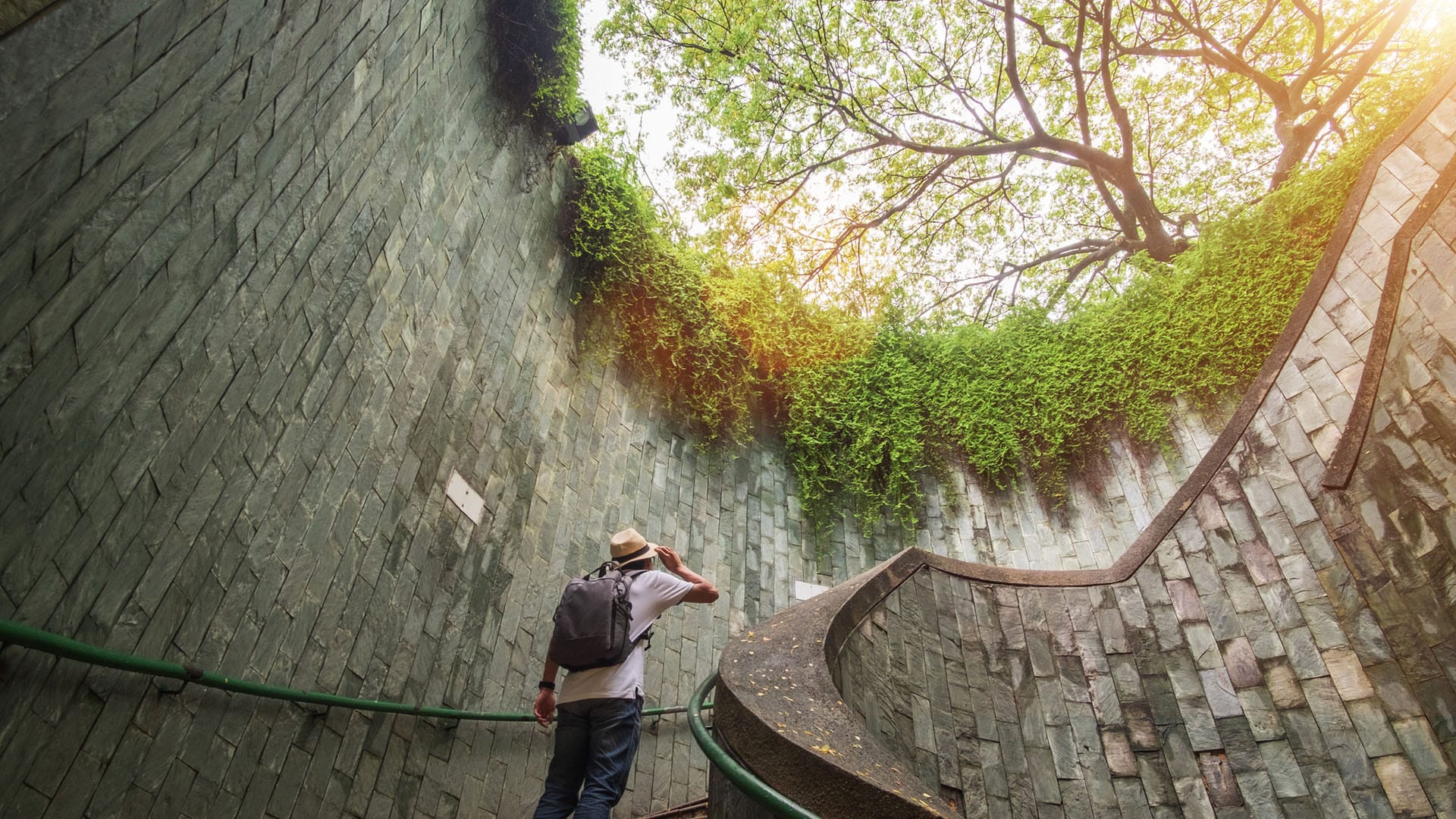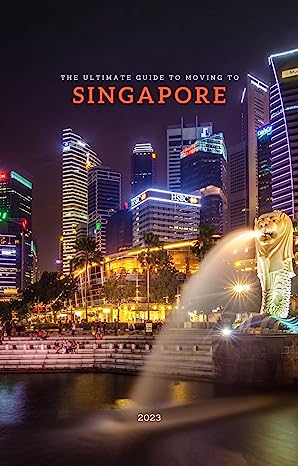Fort Canning Park: A Heritage Haven Amidst Singapore’s Urban Jungle
Fort Canning Park is a historical landmark in Singapore, offering visitors a glimpse into the country’s rich past combined with a serene escape from the urban landscape. Perched on a hill within the Central Area, the park spans 18 hectares and is a nod to the ancient Malay royalty and the British colonialists who left their marks on this locale. Today, it is a popular destination for both locals and tourists, featuring a variety of attractions from the Spice Garden to the Battle Box, a former underground military complex from World War II.
The park serves as a green oasis amidst the bustling city and has been a venue for concerts and cultural events, attracting music and arts enthusiasts alike. Its history interweaves with nature, as towering ancient trees and the diversity of the spice garden provide a tranquil setting. Fort Canning Park is not merely a recreational space but also an educational journey through Singapore’s progression from its early beginnings to the present day.
Visitors can explore the area’s rich heritage by walking the same paths as historical figures once did, learning about the significance of the site through various well-preserved artefacts and structures. From archaeological digs to preserved fort gates and walls, each element within the park adds a chapter to the story of Singapore’s evolution. With its central location, the park is readily accessible, making it an essential part of the experience for anyone interested in exploring Singapore’s blend of history and nature.
History and Significance
Fort Canning Park holds a significant place in Singapore’s multifaceted history, from ancient times to the contemporary period. The park serves as a historical bridge, connecting the country’s rich cultural heritage with its modern-day status.
Historical Timeline
- 14th Century: The hill originally known as Bukit Larangan or ‘Forbidden Hill’, was the seat of royalty for the kingdom of Singapura. Sultan Iskandar Shah, believed to be the last king of Singapura, ruled here.
- 1819: Sir Stamford Raffles, representative of the British East India Company, recognising the hill’s strategic location and its tie to the history of the Malay kings, established a settlement at its base, which formed the nucleus of modern Singapore.
- World War II: The park plays a sombre role in Singapore’s history, as it became the site where the British decided to surrender Singapore to the Japanese, significantly shaping the island’s wartime experience.
Notable Events
- Establishment of Raffles’ House: In the early 19th century, Sir Stamford Raffles built his residence on this hill, which later saw the flagstaff indicating the British presence.
- Archaeological Digs: Numerous excavations have revealed artefacts dating to the 14th century, providing a direct connection to the reign of Sultan Iskandar Shah and early Malay history.
- The Battle Box: During World War II, this underground complex was used as a command centre by the British military and is a significant reminder of the Battle of Singapore.
The yesteryears of Fort Canning Park offer an enduring legacy, reflecting the evolution of Singapore from the powerful seat of Malay royalty in Melaka to a vital hub in colonial and wartime history.
Cultural Heritage
Fort Canning Park serves as a significant historical canvas, showcasing Singapore’s layered past through its preserved sites and informative galleries.
Raffles House
Raffles House, a colonial bungalow, once belonged to Sir Stamford Raffles, the founder of modern Singapore. This structure stands as a heritage site, reflecting the colonial era’s administrative significance.
Keramat Iskandar Shah
Keramat Iskandar Shah is a sacred shrine believed to be the burial site of Iskandar Shah, the last king of ancient Singapura. The site is a testament to the island’s Malay heritage and cultural reverence.
Fort Canning Heritage Gallery
The Fort Canning Heritage Gallery is situated within the Fort Canning Centre. It displays exhibits that narrate the hill’s pivotal historical roles, from its days as Bukit Larangan, or “Forbidden Hill”, to its transformation into a British colonial fort.
Natural Attractions
Fort Canning Park in Singapore is a treasure trove of botanical interest and historical significance. It offers a variety of gardens each providing a distinctive experience with local flora and heritage trees.
Sang Nila Utama Garden
This tranquil space pays tribute to the historic location believed to be the site of the ancient kingdom of Singapura. Visitors encounter a landscape that recreates the royal gardening traditions, with careful plant selection that reflects the history and culture of the Malay world.
Spice Garden
A reconstructed version of the original 19th-century spice garden at Fort Canning Hill, this area showcases a collection of spice plants that were once a cornerstone of the region’s booming spice trade. The Spice Garden not only educates visitors on various spices but also serves as a habitat for endemic plant species, contributing to the park’s biodiversity.
Fort Canning Green
An open field surrounded by lush greenery, Fort Canning Green is a dynamic area that frequently hosts outdoor concerts and theatre performances. With towering trees and open lawns, it’s a popular destination for picnics, leisurely walks, and experiencing the natural ambience created by the harmonious mix of flora.
In each of these sections, the landscape is punctuated with heritage trees, some marked for their significant contribution to Singapore’s natural heritage. The park’s holistic approach preserves the botanical richness and provides public accessibility to these natural landmarks.
Fort Canning Park Today
Fort Canning Park serves as an urban oasis in the bustling city of Singapore, combining rich history with contemporary leisure activities and event offerings to cater to a diverse range of visitors.
Modern Recreational Activities
Visitors to Fort Canning Park can engage in a variety of recreational activities. The park boasts expansive lawns perfect for picnics and leisurely strolls. Its spice garden, historically reflective of its past, is a point of interest for those keen on botanical exploration. Here, one might find families enjoying the outdoors, fitness enthusiasts making use of the park’s natural landscapes, or individuals simply seeking a peaceful retreat from the city’s pace.
Concerts and Events
Fort Canning Park is a favoured location for a spectrum of events, including but not limited to, outdoor concerts. The park’s open green spaces and historical backdrop offer a unique venue that accommodates a variety of public and private events throughout the year. Cultural performances, live music, and festivals utilise this versatile space, providing entertainment against a natural, green canvas that enhances the cultural vibrancy of Singapore.
Historical Monuments
Fort Canning Park features several significant historical monuments which provide insight into Singapore’s military history during World War II. These monuments include the Fort Canning Bunker and the Battlebox, places of strategic importance during the war.
Fort Canning Bunker
The Fort Canning Bunker, also known as the Battlebox, served as an underground command centre during World War II. It was part of the larger fortress that includes the remnants of the fort wall. This bunker was a critical site where pivotal decisions were made, shaping the fate of Singapore during the war.
- Function: Military command centre
- Significance: Illustrates Singapore’s defence strategy during WWII
Battlebox History
The Battlebox history is marked by its role as the last bastion of the British military defence in the region. It witnessed the momentous decision by the British to surrender Singapore to the Japanese forces in 1942.
- Historical moment: British surrender on 15 February 1942
- Structure: Fortified with thick walls and other defensive features
These sites are preserved today, offering visitors a glimpse into the events that unfolded within these walls and the broader narrative of the park’s strategic importance throughout Singapore’s history.
Art and Exhibitions
Fort Canning Park serves as a vibrant showcase for art and exhibitions that span historical depth and cultural diversity. Visitors can engage with an array of sculptures and explore an active archaeological dig site, enriching their experience of Singapore’s heritage.
Sculptures and Art Installations
Colour and creativity flourish amongst the greenery of Fort Canning Park. The ASEAN Sculpture Garden features a collection of artworks contributed by member countries, symbolising unity and diversity within the region. Additionally, visitors can appreciate the talent of local artists, such as Eng Siak Loy, through a trio of vibrant outdoor murals that enliven the park’s atmosphere.
| Location | Artwork |
|---|---|
| ASEAN Sculpture Garden | Sculptures from ASEAN countries |
| Outdoor spaces | Murals by Eng Siak Loy |
Archaeological Dig Site
Fort Canning Park is also home to a significant archaeological dig site, open for public observation, where past excavations have unearthed artefacts dating back to Singapore’s ancient history. This site provides an authentic context for understanding the past activities and lives of people who once interacted with the space, making it a compelling visit for those with an interest in history and archaeology.
Flora and Fauna
Fort Canning Park hosts a rich tapestry of plant species and wildlife. This section details notable trees and the botanical diversity that visitors can observe in the park.
Heritage Trees
The park is recognised for its collection of heritage trees. These are ancient specimens that have withstood the test of time, providing ecological and historical value. The Rain Tree and Tembusu are among these revered giants, with some dating back several decades. They serve as notable landmarks within the park’s expanse, often frequented by birds and small mammals.
Botanical Variety
The botanical variety within Fort Canning Park is extensive, featuring both local and exotic flora. Visitors can find an assortment of tropical plants, including various spices once grown during the colonial era. Each plant and tree contributes to the lush greenery, creating a verdant escape in the midst of the city.
- Fruit Trees: These include the likes of Nutmeg and Cinnamon, which nod to the park’s historical role in the spice trade.
- Ornamental Plants: These not only adorn the landscape but also attract a variety of wildlife, enhancing the park’s ecological diversity.
Park Accessibility
Fort Canning Park boasts a range of entrances and various options for accessibility that cater to the convenience of visitors. This section discusses the methods by which individuals can access the park and the availability of guided tours.
Entrances and Accessibility
Fort Canning Park is accessible via multiple entrances. The park is equipped with escalators and a platform lift to improve access to the hilltop location. This is especially helpful for guests who may require assistance, including the elderly and those with prams. Location is a key factor for visitors, and fortunately, the park is situated centrally, making it easily reachable from several parts of Singapore.
For those travelling by public transport, MRT stations are convenient options. The closest MRT station is Dhoby Ghaut MRT, which provides effortless access to the park. Visitors can exit the MRT station and find entrances to the park within a short walking distance.
- Nearest MRT Stations:
- Dhoby Ghaut MRT (North-South Line, North-East Line, Circle Line)
- Fort Canning MRT (Downtown Line)
The existence of these stations simplifies the approach to Fort Canning Park greatly, making it a relatively simple venture to plan.
Guided Tour Availability
Fort Canning Park offers guided tours that encapsulate the rich history and significance of the area. Tours can provide an informative experience through the park’s heritage sites. Details about these tours, including times and availability, can be obtained from official sources and require prior booking.
- Guided Tours:
- Availability: Check with the National Parks Board for the current schedule.
- Booking: Essential and can be made through the official National Parks Board website.
Amenities and Facilities
Fort Canning Park offers visitors a range of facilities to improve their visit. This includes options for dining and convenient access to restrooms and seating throughout the park.
Food and Dining Options
Restaurants:
- Hotel Fort Canning provides a dining experience that combines both elegance and comfort.
- Le Jardin offers a tranquil setting where visitors can enjoy a meal amidst the greenery.
Bakery:
- Tiong Bahru Bakery is located nearby, known for its freshly baked goods and a cosy atmosphere.
Restrooms and Seating Areas
Restrooms:
Available throughout the park ensuring accessibility for all visitors.
Seating Areas:
Benches and rest spots are strategically placed around the park allowing guests to take a moment to relax.
Educational Opportunities
Fort Canning Park presents a wealth of educational experiences, particularly appealing to those keen on Singapore’s history and the progression from its days under the British army to the Singapore Armed Forces.
Self-Guided Walks
Self-guided walks through Fort Canning Park offer visitors an informative journey into Singapore’s past. Individuals can follow trails that highlight the park’s significance during the British military’s presence. These walks are especially fascinating for history buffs who prefer to explore at their own pace.
- Historic Sites: Key locations include a former British Army barracks and the ASEAN Sculpture Garden.
- Trails: Maps for self-guided tours are available for visitors, detailing various historically significant spots within the park.
Public Lectures and Workshops
The park hosts an array of public lectures and workshops that provide deeper insights into the area’s storied past.
- Topics: Sessions cover topics from archaeology to botany, catering to a diverse range of interests.
- Educators: Experts and historians often lead these educational programmes, giving attendees an in-depth understanding of the park’s history and its transformation over the years.
Visitor Information
Fort Canning Park serves as a historical landmark where visitors can immerse themselves in rich heritage while enjoying the serenity of its natural environment. The park is conveniently accessible and offers an escape from the hustle of city life without any entry charge.
Operating Hours
- Fort Canning Park: Open 24 hours, daily
Admission Fees
- Entrance: Free
- Location: Bounded by Hill Street, Canning Rise, Clemenceau Avenue, and River Valley Road, Singapore
- MRT Access: Dhoby Ghaut, City Hall, and Clarke Quay MRT stations are nearby




